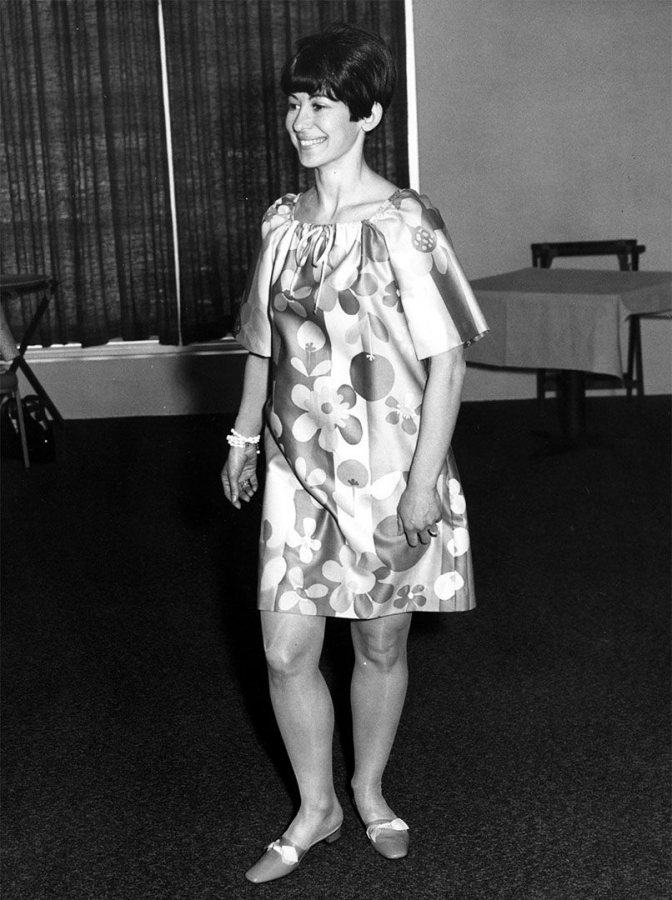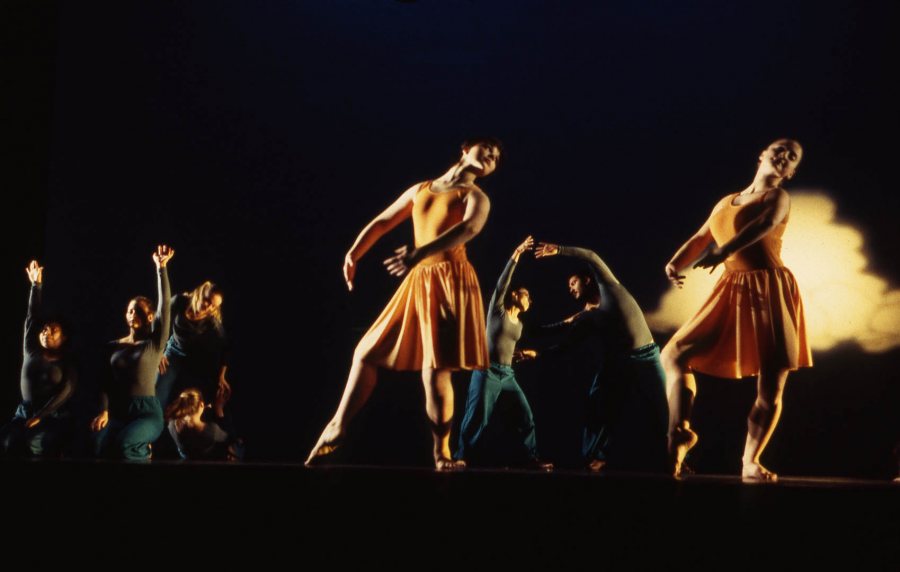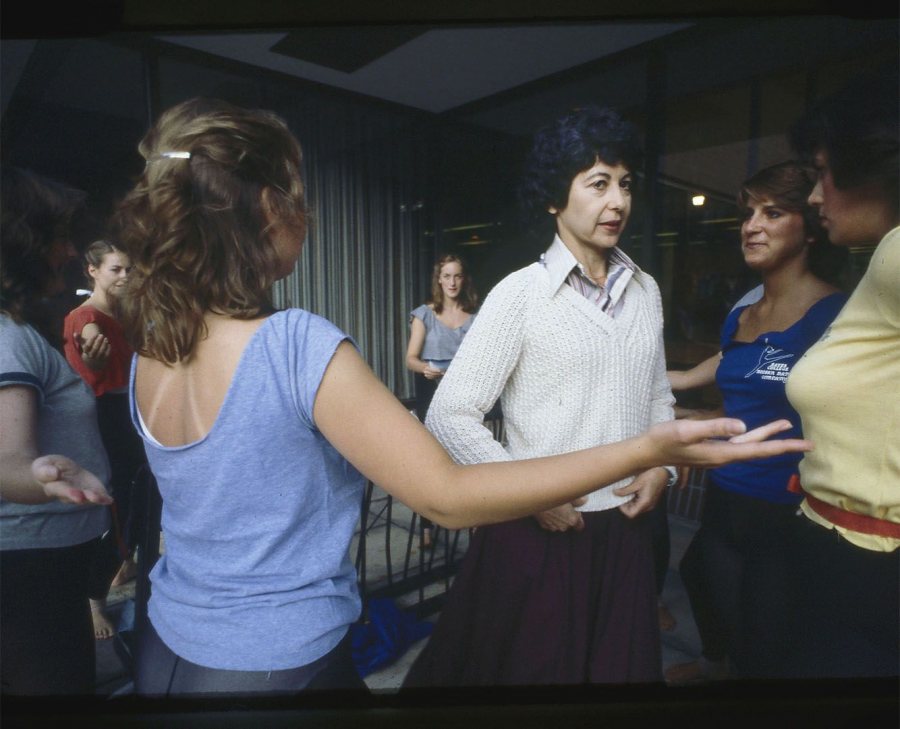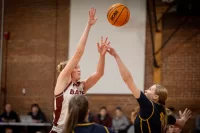
Marcy Plavin, a singular creative force in the growth of dance at Bates and in the lives of generations of dance students and alumni, died on Nov. 3 at age 84.
Hired in 1965 to teach two classes in dance technique in the Department of Physical Education, Plavin became the face and the spirit of the Bates dance program over the next 40 years.
She created the student Bates Dance Company in 1969 and founded the internationally renowned Bates Dance Festival in 1983. She produced more than 150 dance concerts, contributing her own choreography and advising student choreographers; built a robust tradition of bringing Bates dance programs to Lewiston-Auburn schools; and positioned the dance curriculum for its 2011 approval as a major.
Service and Memorial Gift Information
Services for the late Marcy Plavin will be held at 10 a.m. on Sunday, Nov. 6, at Temple Shalom Synagogue, 74 Bradman St., Auburn, Maine. Memorial gifts may be made to the Plavin-Sakolsky Fund for Dance, Office of College Advancement, Bates College, 2 Andrews Road, Lewiston ME 04240.
Plavin’s suite of programmatic accomplishments was matched, and perhaps exceeded, by her peerless reputation for mentoring her students.
“To her students who became her alumni devotees, Marcy Plavin was a constant mentor who offered fundamental inspiration — a spirited defender and nurturer of their aspirations and dreams,” said President Clayton Spencer in her message to the campus community.
Plavin earned a bachelor’s degree from the University of Maine in 1971 and a master’s from Wesleyan University in 1984. Initially a member of the Department of Physical Education, she joined what is now the Department of Theater and Dance in 1978.
In 2000, gifts from alumni of the Bates Dance Company funded the Marcy Plavin Dance Award, and in 2004, alumni gifts funded the creation of the Marcy Plavin Dance Studios in Merrill Gymnasium.
Plavin retired as lecturer emerita in dance in 2005 and received the Distinguished Service Award from the college’s alumni service, leadership, and honor organization, the College Key, in 2009.
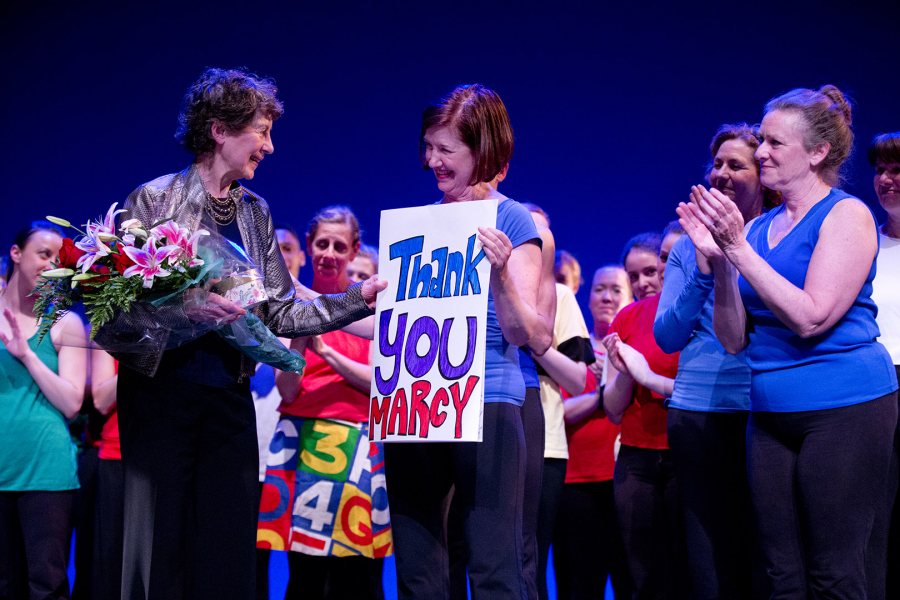
Geri FitzGerald ’75 holds a thank-you sign for Marcy Plavin at the conclusion of the 2015 dance reunion concert in Schaeffer Theatre. (Phyllis Graber Jensen/Bates College)
Entrée ‘to the world of artistic creation’
Dance critic and historian Suzanne Carbonneau ’76 wrote, in 2003, that Plavin provided an entrée “to the world of artistic creation” for her students.
“We learned that passionate engagement, an appreciation of the sublime, and the cultivation of compassion are forms of knowledge that none of us can afford to be without.”
John Carrafa ’76, twice a Tony Award nominee for his choreography, said Plavin “encouraged us to have a broadly contextualized perspective on dance. She exposed us to a tremendous variety of choreographers and ways of approaching movement. What she provided for us really underscored the best of a liberal arts education — the importance of questioning.”
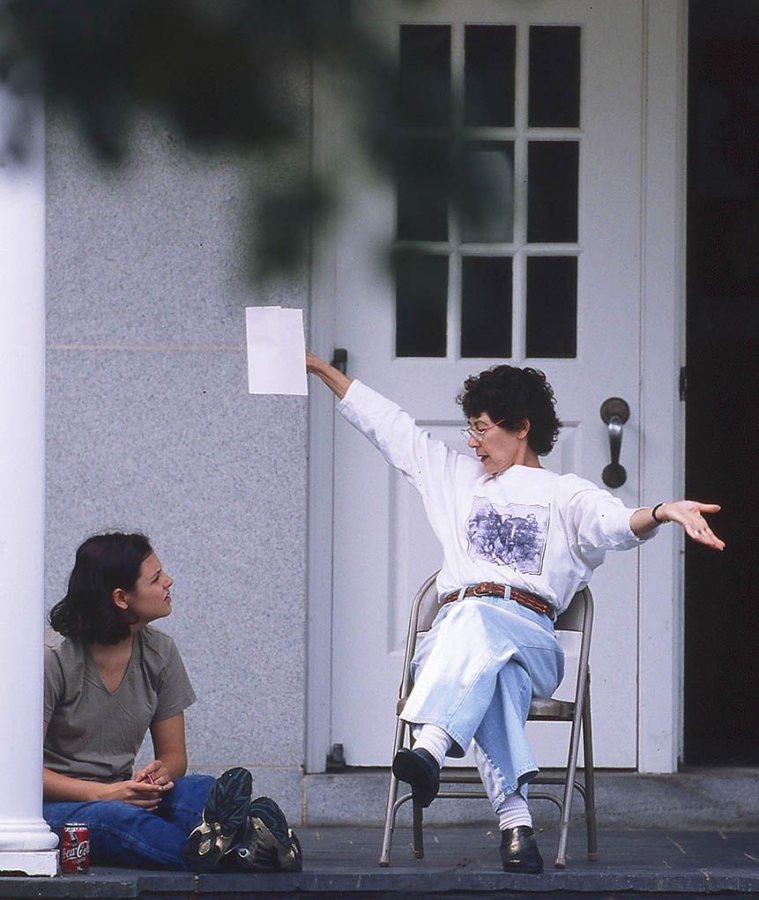
Marcy Plavin meets with a student outside Schaeffer Theatre in 1999. (Phyllis Graber Jensen/Bates College)
‘Nobody, and no body, is marginalized’
If the arts landscape of the early 1970s was less developed than it is today, it was also open ground for someone with Plavin’s creative and inclusive entrepreneurism.
An emphatic, direct speaker with a fatalistic wit that revealed a New York background, Plavin recruited the students she needed to build and expand the program and forced the college to pay attention to this art form taking shape in Schaeffer Theatre.
For example, when an athlete had a falling out with his track coach, Plavin quickly recruited the student, Matthew Cassis ’72, to play a huge role — the title role — in the 1970 dance interpretation of The Who’s rock opera, Tommy.
“Dance was, and is, the meeting place for every kind of person at Bates,” said Stan Pelli ’77 in 1973. “Dance goes well beyond just welcoming every flavor. It involves using them in the integral part of the activity. Nobody, and no body, is marginalized. We all fit together, as one, creating art through space and time with our bodies.”
‘Suddenly, everyone’s got the beat’
In a 1999 profile in Bates Magazine, writer Doug Hubley described the sensation of watching a Plavin dance class move from chaos to creation in 90 minutes.
“It just seems chaotic until — suddenly — everyone’s got the beat, got the moves, got it together,” he wrote. “Now, bang, it’s a dance. And as dance is meant to, it’s riveting your eye, lifting your spirit.”
That magical e pluribus unum moment defined “the essence and symbol” of Plavin work at Bates, he wrote. She had the gift of “making one from many, making wholes that transcend the sums of their parts. Even, at the start, making something from nearly nothing.”
And she taught her students how to find and hold on to that power to create.
As Carbonneau said, “It was always about exposing us to a lot of different stuff and encouraging us to go where our interests were.”
No-drama zone
Plavin ran a no-drama dance company.
“No matter what’s happening, through obstacles along the way, she just perseveres,” said her friend Paula Matthews in 1999. “She’s matter-of-fact about it.”
Michael Foley ’89, now an associate professor of dance at the University of South Florida, recalls the time that he, Kristen Purdy Russett ’88, and Susan Rooney ’91 were hired to perform a dance in Lewiston.
Turns out, the client thought he was hiring strippers. Afterward, Plavin checked in on her dancers and found out what happened. Shock? Outrage? Riling up the horses? Nope.
“Well, at least you got paid,” she said.
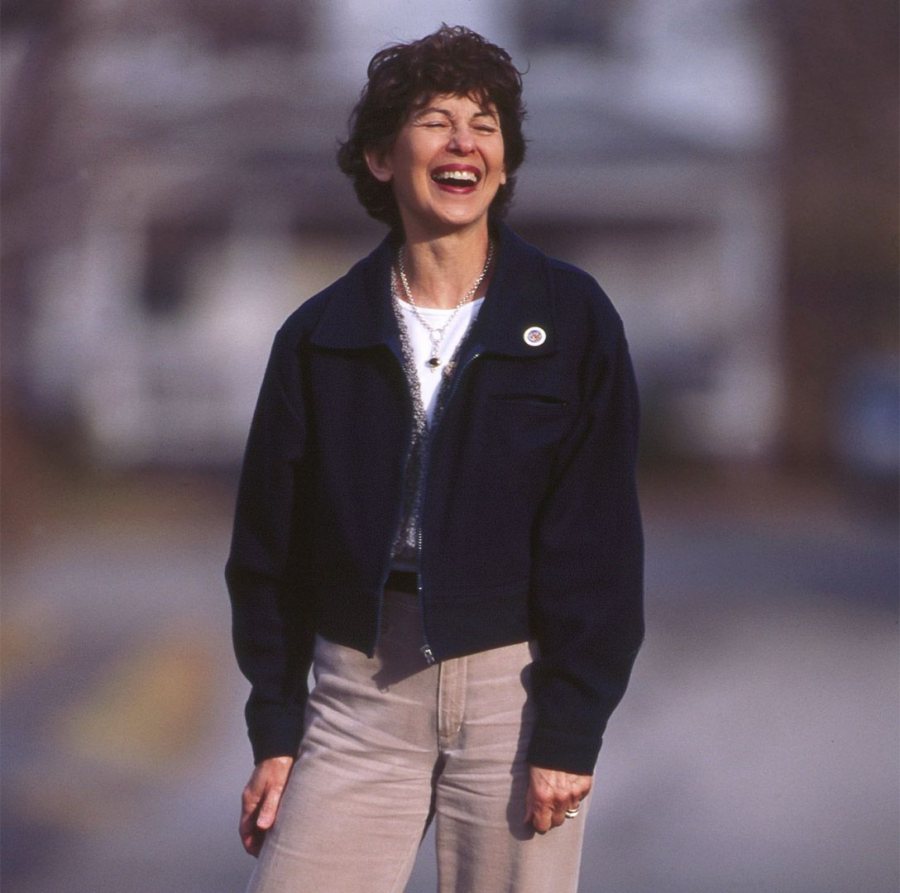
Marcy Plavin, photographed near her home on Mountain Avenue in fall 1998. (Phyllis Graber Jensen/Bates College)
‘She was in complete control’
Dervilla McCann ’77, a cardiologist and member of the college’s Board of Trustees, remembers her first impression of seeing Plavin run her dance class. In a dimly lit gym was “a dark-haired, muscular, vivacious, beautiful woman who had a group of people doing everything she said. Immediately. I mean, she was in complete control.”
Prior to coming to Bates, Plavin studied dance in New York with German expatriate Hanya Holm, one of the four figures considered the founders of American modern dance, with Martha Graham, Doris Humphrey, and Charles Weidman.
Plavin regarded Holm as a key influence because, unlike Graham and Humphrey, Holm emphasized developing a strong body and physical capability rather than a signature style. Working with Holm, Plavin says, “I realized one day that I wasn’t bound by anything, that there was this tremendous freedom of where to go, what to do, what you use, and what you were going to choreograph.”
In turn, Plavin instilled in her students this freedom to create. “They can take the creative process with them in anything that they do in their lives,” she said.
‘Having it all’
A mentor’s life plays out on a stage of sorts. When the curtain comes up, the audience of mentees watch, learn, are inspired, and sometimes ask, “How’d she do that?”
Particularly for Bates women in the late 1960s through the 1980s, Plavin may have been the first woman they met who was, in the parlance of the era, “having it all — career, creative life, and family,” wrote Hubley in his 1999 profile.
Said Carbonneau, “We saw her integrating all aspects of her life.” For students, that integration was on view at the Plavins’ Mountain Avenue home, which Marcy and her husband, Leonard, flung open for her students and dance alumni.
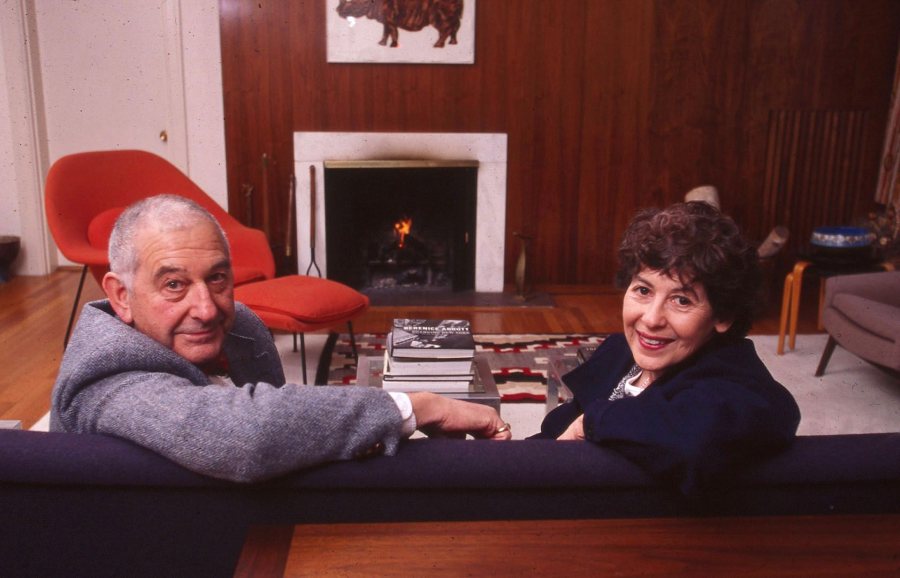
Marcy and Leonard Plavin pose for a portrait at their Mountain Avenue home in 1999. (Phyllis Graber Jensen/Bates College)
‘Caring that none of them ever bargained for’
In this clip from the 2004 documentary Marcy Plavin: 35 Years of Bates Dance, the late Leonard Plavin talks about Marcy’s remarkable connection to her students.
For Plavin, the mentoring never ended. As late as 2014, dance students crossing the Commencement stage to receive their diplomas would reach out to Plavin, a faculty marshal assisting with the conferrals, for an embrace that she always warmly returned.
‘Brightened the lives, lifted the spirits’ (and more)
In 2003, as Plavin began her retirement from Bates, her colleague Eric Wollman, professor of physics, wrote the traditional faculty tribute.
Plavin, he said, “has single-handedly brought Bates to national prominence in dance, which seems almost incidental to the fact that along the way she has brightened the lives and lifted the spirits of thousands of people.”
Importantly, Wollman’s tribute also placed his colleague’s accomplishments into a larger academic and institutional context:
She has collaborated with colleagues, advised independent studies, arranged visits by guest artists, sought and received grants in support of dance, served on various college committees, contributed to the general welfare of her department, advanced the public understanding and appreciation of dance, in particular, and the arts, in general, and provided assistance to a wide variety of civic and professional organizations.
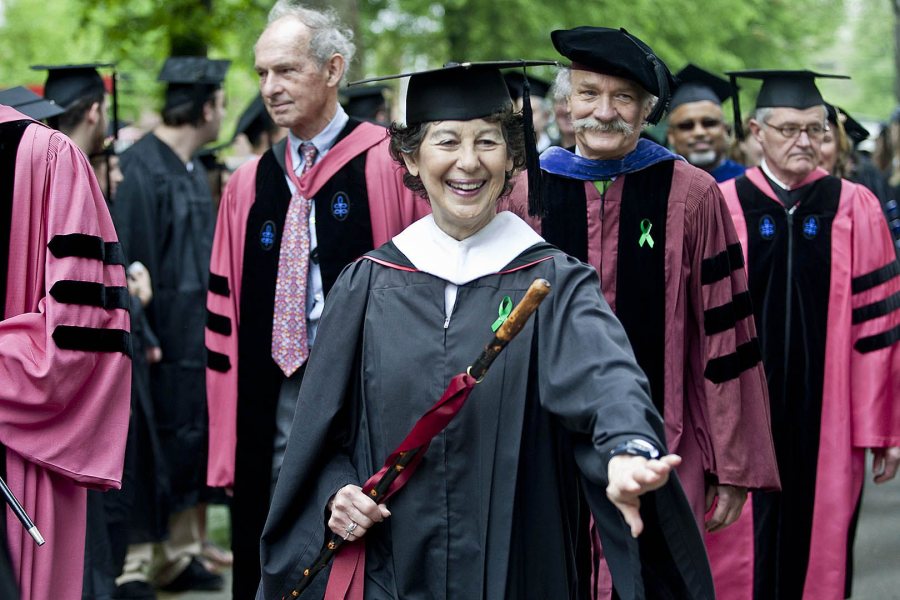
Marcy Plavin leads her colleagues as a faculty marshal at Commencement 2011. A marshal from 2002 to 2014, Plavin relished the honor, from organizing her colleagues before the event to leading the faculty procession and helping with the presentation of diplomas, all with grace and energy. (Phyllis Graber Jensen/Bates College)
‘More than just a dance’
Plavin’s former students returned several times to Bates for reunions — a day or two of rehearsals, then an evening concert on the last day.
If prior reunions were about reminiscing, the reunion in 2011, following the death of Plavin’s husband, Leonard, and the reunion in May 2015, as Plavin grew frail, were more about paying tribute.
Dance Reunions 2011 and 2015
The 2011 Dance Reunion and the 2015 Dance Reunion in text and photographs.
At the 2011 reunion, McCann remarked on the camaraderie and “the way people moved together and the way they laughed together,” in a way that “really made it clear to me that this was more than just a dance. It was a renewal of friendships.”
In 2015, the alumni presented dances created at Bates throughout Plavin’s tenure, ranging back to 1969. The dancers arranged themselves into eight teams according to class year, each team choreographing and performing one segment of Marcy’s Legacy.
Yes, Plavin said, “we’re bringing back my work, but we’re celebrating just getting together, which we always do.”
Plavin was once asked if she was, after all she had done and accomplished, a symbol of Bates itself?
“I don’t know about that,” she responded with typical Plavin deflection. But, she continued, “I feel that if I’ve touched [students’] lives in some way, it’s not so much that they remember me but they remember their experience at Bates, that it’s been successful for them.”
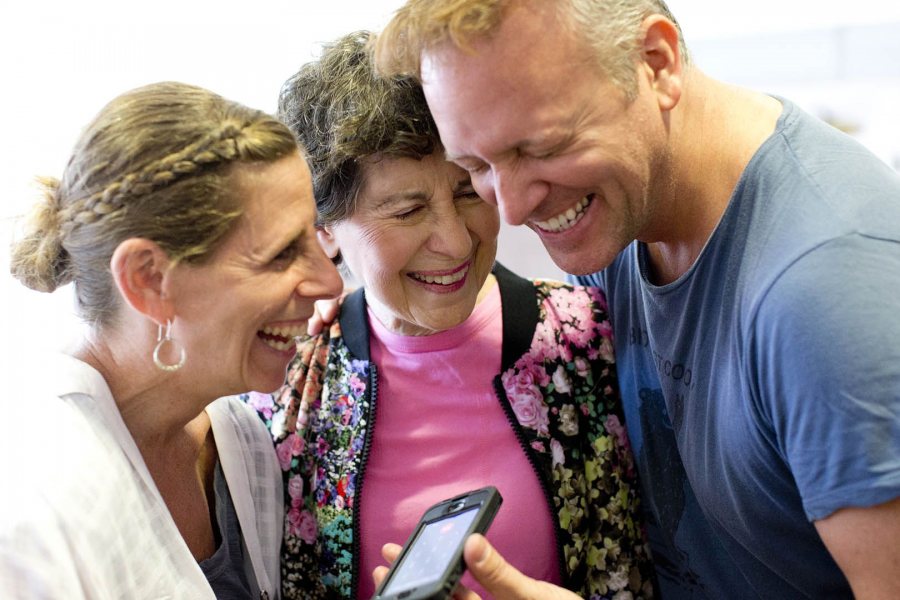
Rachel Segall ’91 and Michael Foley ’89 embrace Marcy Plavin on May 2, 2015, during rehearsals for the evening’s alumni dance concert to honor Plavin. (Phyllis Graber Jensen/Bates College)
Material from the publication Bates College Modern Dance Company Celebrates 35 Years appears in this story. The film documentary Marcy Plavin: 35 Years of Bates Dance was written, produced, and directed by David Iverson and Laura Iverson Beare ’01.
